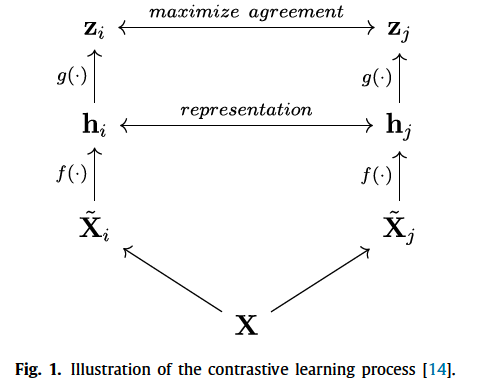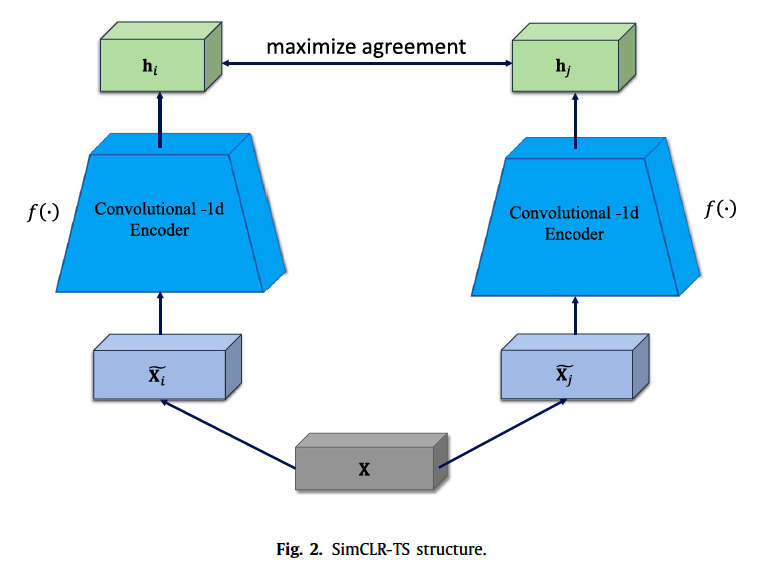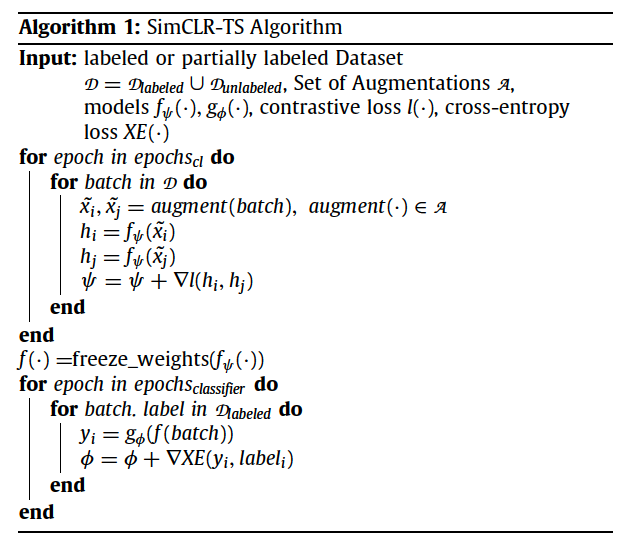Contrastive Learning based self-supervised TS
Contents
- Abstract
- Introduction
- Related Work
- Contrastive Learning
- DA for TS data
- Self-Supervised TS Analysis
- Problem Statement
- SimCLR
- SimCLR-TS
- CNN-1D encoder
- Data Augmentation
0. Abstract
SSL : usually accomplished with some sort of data augmentation
This paper :
- presents a novel approach for SSL based TS anlaysis, based on SimCLR
- present novel data augmentation
- focusing especially on TS data
1. Introduction
propose SimCLR-TS
- SimCLR ssl based industrial TS analysis framework,
- SimCLR framework
- composition of multiple data-augmentation techniques
Conventional Data Augmentations
-
ex) rotation, crop and resize and color distortion
\(\rightarrow\) cannot be applied as they are for TS
( \(\because\) inherent characteristics of temporal and dynamic dependencies in MTS )
\(\rightarrow\) Propose multiple augmentation techniques for TS
2. Related work
(1) Contrastive learning
proposed contrastive learning methods can be categorized into …
- (1) Context-Instance contrast methods
- ex) principle of predicting relative position
- ex) maximizing mutual information
- (2) Context-Context contrast methods
- learning in a discriminative fashion from individual instances.
- ex) deep clustering approach
- Swapping Assignment between multiple Views (SwAV)
Similar works to our proposed :
( both deal with very specific signals )
- (1) CLAR
- (2) SeqCLR
\(\leftrightarrow\) proposed : deal with MTS of a arbitrary and mixed physical units which can affect the choice of suitable augmentations
a) CLAR
-
classification of audio samples based on SimCLR
-
also utilize time–frequency domain
( \(\leftrightarrow\) proposed : work only on the raw data & do not need to deal with multiple channels of different signals )
-
pre-training is not fully unsupervised
\(\rightarrow\) just aimed for boosting the raw performance
( \(\leftrightarrow\) proposed : aim to create the most meaningful latent representation in a fully unsupervised way )
-
train their evaluation head always on the fully labeled data
( \(\leftrightarrow\) train our final classifier with only fractions of the labeled data )
b) SeqCLR
- specifically concerned with EEG signals
-
aim to extract features from a single channel & to learn a corresponding representation for this single channel
-
\(\therefore\) feed their data sequentially!
( \(\leftrightarrow\) feed and process multichannel data of different physical units simultaneously )
-
combine channels to form new ones & recombination of different datasets as a significant performance booster
\(\rightarrow\) not applicable with arbitrary multichannel time-series data
(2) Data-augmentation for TS data
a) NLP
- either replacing a token with its synonym
- generating new data samples with back-translation
\(\rightarrow\) cannot be transferred to the general TS
b) TS
-
categorized into
- (1) time-domain
- (2) frequency domain
- (3) hybrid approaches
- this paper focus on … (1) time-domain DA
-
ex) window warping
-
speeding up (upsampling) and slowing down (down-sampling) of the time-series
-
larger time-series signal is splitted into multiple smaller signals
and a moving average smoothing with different window
-
- ex) jittering, scaling, rotating, permutating, magnitude warping and time warping
- ex) Dynamic Time Warping (DTW) Barycentric Averaging (DBA) :
- weighted version of the time series averaging method
- propose 3 weighting methods to choose the weights to assign to theseries of the dataset
-
- this paper aims to to achieve augmentation strategy to have uniform features that preserves maximal information and aligned features for similar examples
3. Self-Supervised TS Analysis
(1) Problem Statement
Assumptions :
- have a dataset of TS from arbitrary sources
- these sources can generate either discrete/continuous values
-
No feature extraction techniques have been used
-
input : raw TS
-
only normalization has been used
-
- No additional statistical test have been undertaken
Notation
- MTS : \(\left\{\mathbf{x}_1, \mathbf{x}_2, \ldots, \mathbf{x}_T\right\}\) where \(\mathbf{x}_i \in \mathbb{R}^m\),
- \(m\) : number of variables
- \(T\) : length of TS
- labels : \(\left\{y_1, y_2, \ldots, y_T\right\}\)
-
neural network : \(f(\cdot)\)
- linear classifier : \(g(\cdot)\)
(2) SimCLR

- \(l_{i, j}=-\log \frac{\exp \left(\operatorname{sim}\left(\mathbf{z}_i, \mathbf{z}_j\right) / \tau\right)}{\sum_{k=1}^{2 N} \mathbb{1}_{k \neq i} \exp \left(\operatorname{sim}\left(\mathbf{z}_i, \mathbf{z}_k\right) / \tau\right)}\).
(3) SimCLR-TS
subtle differences
-
diff 1 : consider TS instead of images
-
diff 2 : \(f(\cdot)\) structure
- SimCLR : ResNet-50
- SimCLR-TS : 1D convolution
-
diff 3: refrain from using the additional non-linearity \(g(\cdot)\) during contrastive training
- experienced no benefit by using the additional network
- avoid unnecessary computation time and memory consumption.
\(\rightarrow\) directly train to maximize agreement on the latent representations \(h_i\) and \(h_j\)
- \(l_{i, j}=-\log \frac{\exp \left(\operatorname{sim}\left(\mathbf{h}_i, \mathbf{h}_j\right) / \tau\right)}{\sum_{k=1}^{2 N} \mathbb{1}_{k \neq i} \exp \left(\operatorname{sim}\left(\mathbf{h}_i, \mathbf{h}_k\right) / \tau\right)}\).
-
diff 4 : propose a novel set of DA designed for TS


(4) CNN-1D encoder
-
receptive field of size \(n_r \times m\)
-
strides over \(T \times m\) sequences
-
\(p\)-th convolution 1D kernel in the first layer :
- 2d tensor \(K^{(p)}=\left[k_{i, j}^{(p)}\right] \in \mathbb{R}^{n_r \times m}\)
- indices \(i, j\) : the dimension along the time and variable
- 2d tensor \(K^{(p)}=\left[k_{i, j}^{(p)}\right] \in \mathbb{R}^{n_r \times m}\)
-
outputs ( feature maps ) : 1-dim tensor \(H=\left[h_i\right]\).
-
usually use multiple kernels \(\rightarrow\) multiple feature maps
\(\rightarrow\) 2-dim tensor \(H=\left[h_{i, p}\right]\)
-
\(\begin{aligned} &h_{i, p}=(x * k)_i=\sum_{g=1}^{n_r} \sum_{f=1}^m x_{i+g-1, f} \cdot k_{g, f}^p \\ &\forall i \in\left\{1, \ldots, T-n_r+1\right\} \\ &\forall p \in\left\{1, \ldots, d_{q+1}\right\}, \end{aligned}\).
- \(h_{i, p}\) : output of the \((i)^{\text {th }}\) receptive field & \(p\)-th kernel
- \(x_{i+g-1, f}\) : elements in the receptive field of the input variable
- \(k_{g, f}\) : kernel
- \(d_{q+1}\) : number of kernels
(5) Data Augmentation

